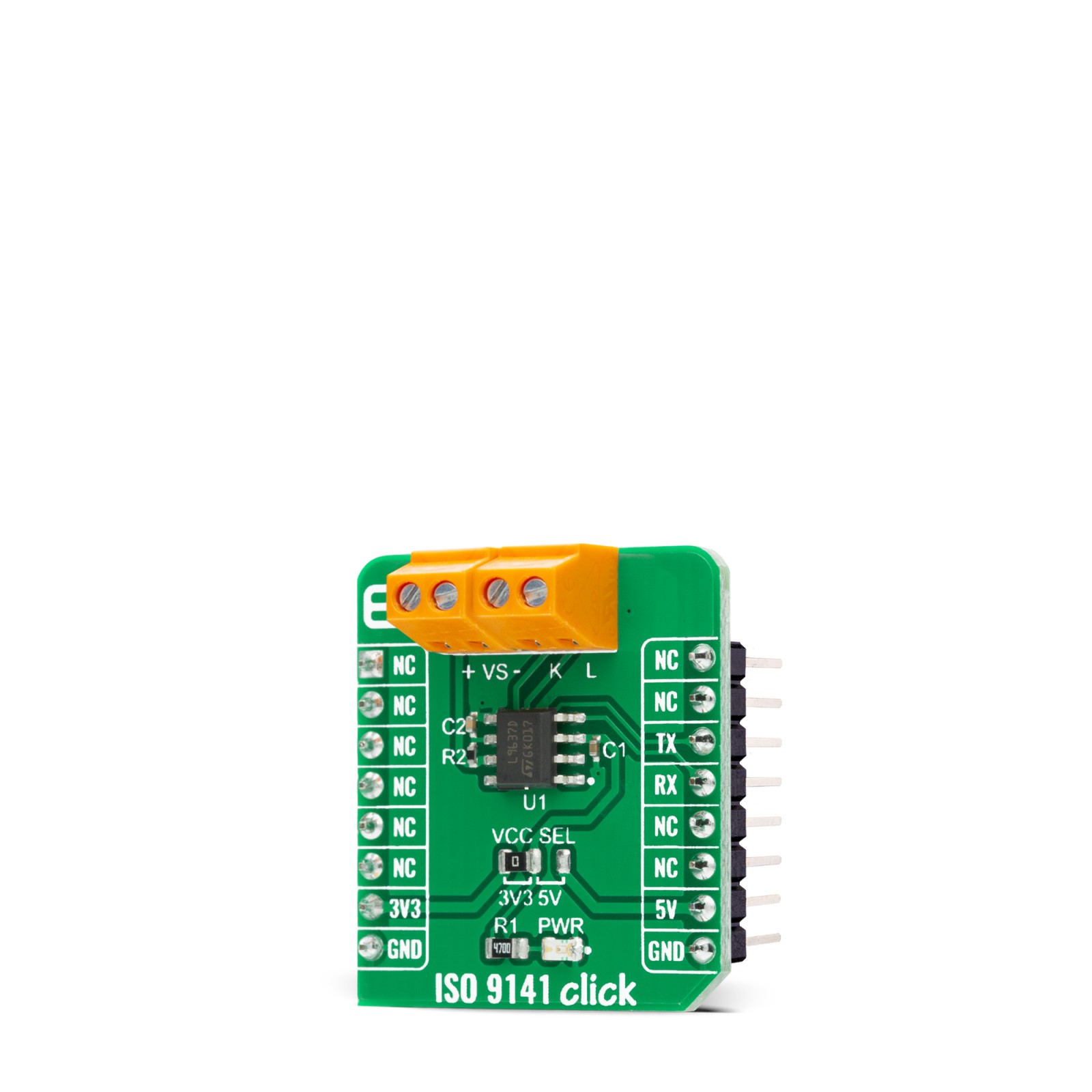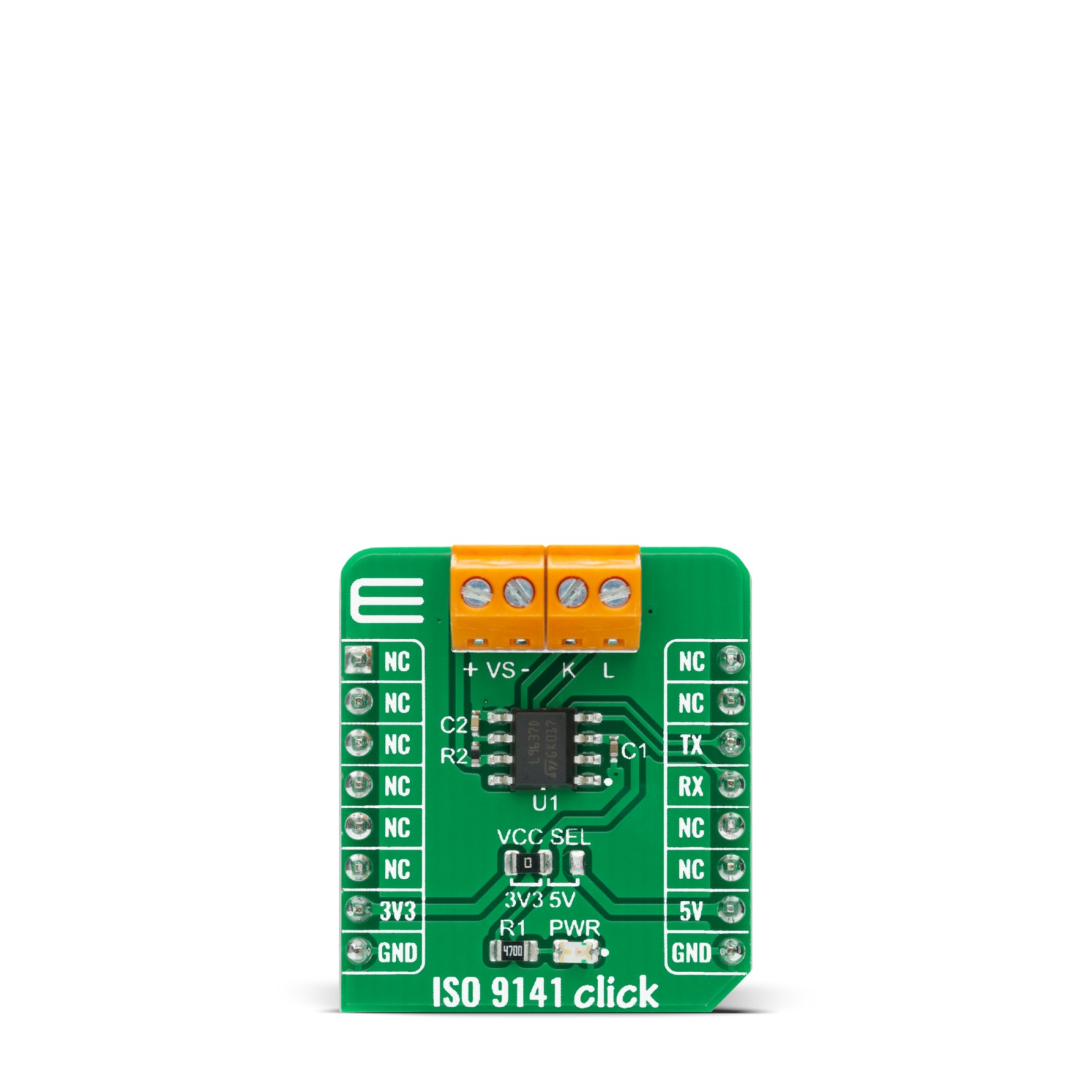ISO 9141 Click is a compact add-on board that contains a monolithic bus driver with ISO 9141 interface. This board features the L9637, a monolithic integrated circuit containing standard ISO 9141 compatible interface functions from ST Microelectronics. It’s designed to provide bidirectional serial communication compatible with ISO9141 standard. It has many features such as wide input/output voltage range, controlled output slope for EMI, Standby Mode with low current consumption, overtemperature Shut-Down function, and more. This Click board™ is suitable for automotive diagnostic applications such as powertrain for ICE (CNG/LPG engine control or diesel/gasoline injection), an automotive gateway in telematics and networking, and many more.
ISO 9141 Click is supported by a mikroSDK compliant library, which includes functions that simplify software development.
ISO 9141 Click is based on the L9637, a monolithic bus driver designed to provide bidirectional serial communication in automotive diagnostic applications according to the specification "Diagnostic Systems ISO9141" from ST Microelectronics. The L9637 is also known as the K-Line Transceiver that provides a bidirectional link, called K, and a separate comparator, called L, to the related diagnosis bus that can be connected on terminal labeled with K and L on this Click board™. The K and L pins are protected against overvoltages and reverse battery condition. During the lack of power supply or ground, all pins show high impedance characteristics.
The L9637 has a wide supply voltage in a range from 4.5V to 36V, as well as several modes of operation like Standby Mode with low current consumption and overtemperature Shut-Down Mode. The overtemperature Shut-Down Mode switches OFF the K output if the L9637’s temperature increases above the thermal shut down threshold. To reactivate K again the temperature must decrease below the K switch ON temperature value. To achieve no fault for power supply under-voltage conditions the outputs will be switched OFF and stay at high impedance.
ISO 9141 Click communicates with MCU using the UART interface with the default baud rate of 9600bps, and commonly used UART RX and TX pins for the data transfer. The UART input TX and output RX of K are associated with the logic voltage level from mikroBUS™ (VCC) with its integrated pull-up resistances. Also, the L comparator output pin named LO has a pull-up resistance connected to VCC. All bus defined inputs L and K have supply voltage-dependent thresholds together with sufficient hysteresis to suppress line spikes.
This Click board™ is easy to program because it does not require an overly demanding configuration. Only what is necessary for the errorless work is the selection of the appropriate mode of operation, whether the Click board™ will work as a receiver or transmitter. In this way, the transmitter will send the data every 2 seconds while the receiving side will receive the data in a „byte-by-byte“ format. This can also be seen in an example code that contains easy to use functions that may be used as a reference for further development.
This Click board™ is designed to be operated with both 3.3V and 5V logic voltage levels that can be selected via VCC SEL jumper. This allows for both 3.3V and 5V capable MCUs to use the UART communication lines properly. However, the Click board™ comes equipped with a library that contains easy to use functions and an example code that can be used as a reference for further development.
- Interface: UART
- Compatibility: mikroBUS™
- Dimensions: 28.6 x 25.4mm
- Input Voltage: 3.3V or 5V
- Supply Voltage: Min. 4.5V, Max. 36V
- K Output Current: 60 mA
- Transmission Frequency: 50 kHz
- Operating Temperature Range: Min. -40°C, Max. +150°C
Comments
Looking for answers to technical questions?
We welcome your comments and suggestions below. However, if you are looking for solutions to technical questions please see our Technical Assistance page.
Customer Reviews
No reviews yet.



